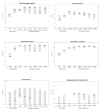Microbiological and Physico-Chemical Changes During Manufacture of an Italian Goat Cheese Made from Raw Milk
- PMID: 27800372
- PMCID: PMC5076699
- DOI: 10.4081/ijfs.2014.4586
Microbiological and Physico-Chemical Changes During Manufacture of an Italian Goat Cheese Made from Raw Milk
Abstract
The aim of this work was to study the microbiological and physico-chemical changes throughout three cheesemaking replicates of Italian Formaggelle di capra cheese made from raw goat milk. Therefore, during the process, three samples of milk, curd and cheese at 3, 7, 11, 14, 21 and 30 days of ripening old cheese were taken from three cheesemaking replicates. The average of total mesophilic bacteria and Enterobacteriaceae count in raw milk was 5.27±0.57 and 3.8±1.02 Log cfu/mL, respectively. Lactic acid bacteria was the predominant bacterial group during the process, and they developed in different ways in each of the media used (M17 and MRS agar). Variability of microbial concentrations was observed between three cheesemaking replicates. A correlation between the presence of higher levels of Enterobacteriaceae in milk and the presence of other contaminants bacteria such as Escherichia coli β-glucuronidase-positive and coagulase-positive staphylococci was observed. In cheesemaking replicate n. 2, E. coli level was 5.07±0.03 Log cfu/mL and increased by about 1 log until the last week of ripening, when the level decreased to 5.69±0.2 Log cfu/mL. The milk used for the cheesemaking replicate n. 2 was found to be contaminated also by coagulase-positive staphylococci (3.18±0.06 Log cfu/mL), but the behaviour of this group appeared to be very variable. In this study a first step of process control and microbial groups study was performed and the cheesemaking process was registered in the website www.ars-alimentaria.it, the Italian site supported by the Italian Board of Health.
Keywords: E. coli; Microbiological dynamics; Natural contamination; Raw goat milk cheese; Staphylococci.
Conflict of interest statement
the authors declare no potential conflict of interests.
Figures


Similar articles
-
Behaviour of Escherichia Coli O157:H7 During the Manufacture and Ripening of an Italian Traditional Raw Goat Milk Cheese.Ital J Food Saf. 2014 Feb 4;3(1):2243. doi: 10.4081/ijfs.2014.2243. eCollection 2014 Jan 21. Ital J Food Saf. 2014. PMID: 27800324 Free PMC article.
-
Effect of Lactic Acid Bacteria Addition on the Microbiological Safety of Pasta-Filata Types of Cheeses.Front Microbiol. 2020 Dec 7;11:612528. doi: 10.3389/fmicb.2020.612528. eCollection 2020. Front Microbiol. 2020. PMID: 33365023 Free PMC article.
-
Tracking microbial quality, safety and environmental contamination sources in artisanal goat cheesemaking factories.Food Microbiol. 2023 Sep;114:104301. doi: 10.1016/j.fm.2023.104301. Epub 2023 May 3. Food Microbiol. 2023. PMID: 37290877
-
Lactic acid bacteria in cow raw milk for cheese production: Which and how many?Front Microbiol. 2023 Jan 12;13:1092224. doi: 10.3389/fmicb.2022.1092224. eCollection 2022. Front Microbiol. 2023. PMID: 36713157 Free PMC article. Review.
-
Invited review: Microbial evolution in raw-milk, long-ripened cheeses produced using undefined natural whey starters.J Dairy Sci. 2014 Feb;97(2):573-91. doi: 10.3168/jds.2013-7187. Epub 2013 Dec 2. J Dairy Sci. 2014. PMID: 24290824 Review.
Cited by
-
Somatic Cell Number, Physicochemical, and Microbiological Parameters of Raw Milk of Goats During the End of Lactation as Compared by Breeds and Number of Lactations.Front Vet Sci. 2021 Sep 3;8:694114. doi: 10.3389/fvets.2021.694114. eCollection 2021. Front Vet Sci. 2021. PMID: 34540931 Free PMC article.
References
-
- AND International, 2011. Evaluation of CAP measures for the sheep and goat sector. Avaiable from: http://ec.europa.eu/agriculture/eval/reports/sheep-goat/syn_sum_en.pdf
-
- Beresford TP, Fitzsimons NA, Brennan NL, Cogan TM, 2001. Recent advances in cheese microbiology. Int Dairy J 11:259-74.
-
- Buffa M, Guamis B, Royo C, Trujillo A, 2001. Microbiological changes throughout ripening of goat cheese made from raw, pasteurized and high-pressure-treated milk. Food Microbiol 18:45-51.
-
- Cogan TM, 2000. Cheese microbiology. In: Fox P.F., Guinee T., Cogan T.M., McSweeney P.L.H. (eds.), Fundamentals of cheese science. Aspen Publ., Gaithersburg, MD, USA: pp. 306-10.
LinkOut - more resources
Full Text Sources
Other Literature Sources

